Family : Cycadaceae

Text © Prof. Pietro Pavone

English translation by Mario Beltramini
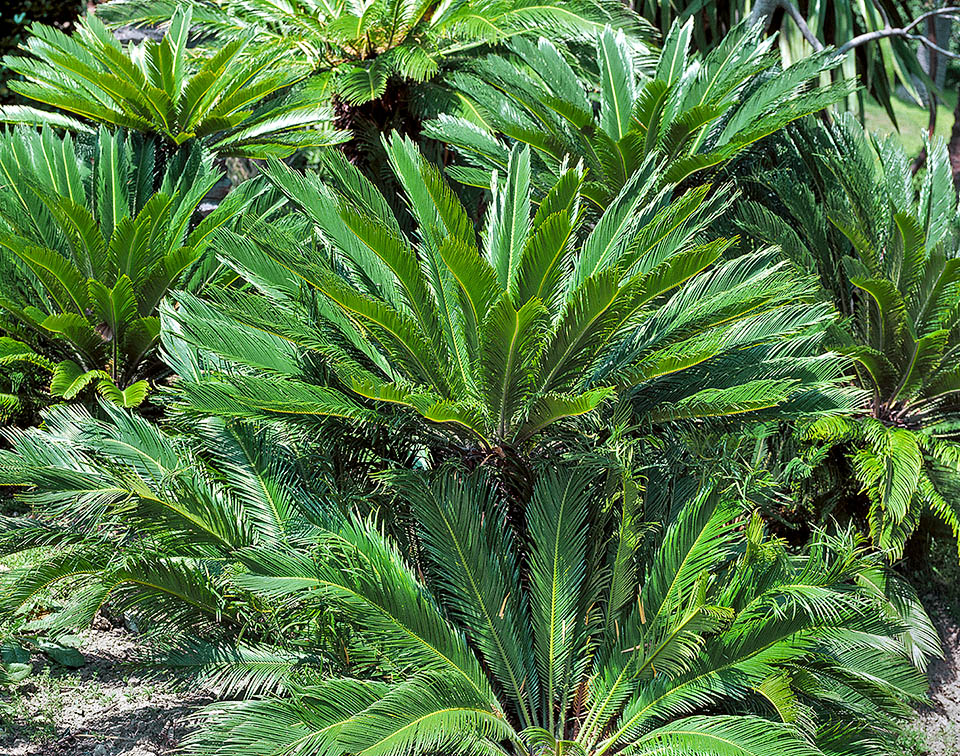
Authentic living fossil, Cycas revoluta appeared before the dinosaurs, when the flower had not yet been invented and the Gymnosperms reigned © Giuseppe Mazza
Cycas revoluta Thunb. is a species of the family Cycadaceae that includes the only genus Cycas with about 118 species native to the tropical regions. Cycas revoluta has been the second species of the genus to be recognized, collected in Japan in 1775-1776 by Carl Peter Thunberg (1743-1828), swedish botanist and physician, who described it a few years later il the publication of the Dutch Society of Sciences in Haarlem (Verh. Holl. Maatsch. Weetensch. Haarlem 20: 424, 1782).
It was planted in Europe for the first time in 1793 at the Palermo Botanical Garden, gift of the Queen Maria Carolina of Austria (1752-1814), wife of King Ferdinand I of the Two Sicilies (1751-1825).
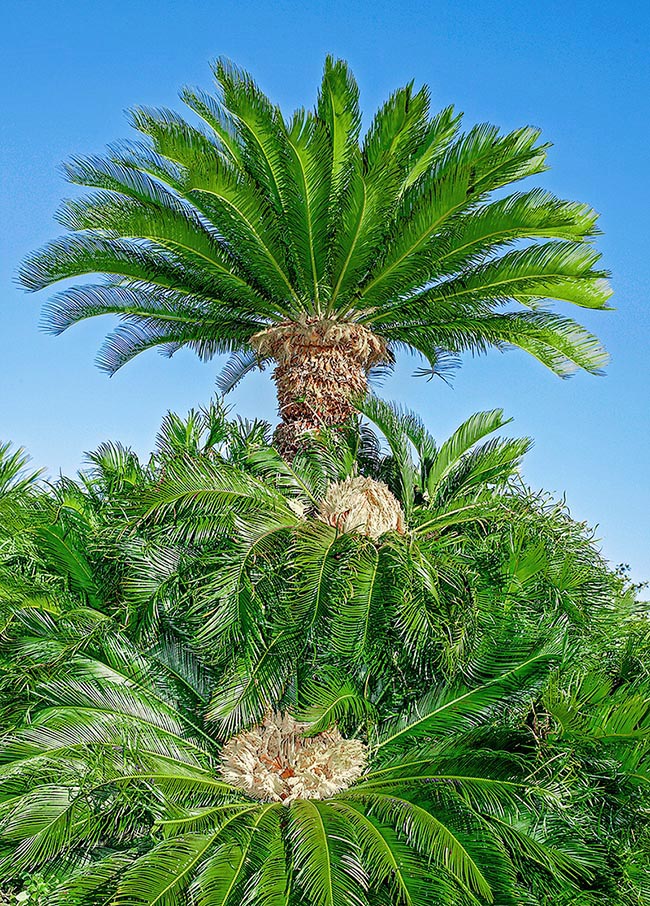
Presently deemed native to South China, Taiwan and southern Japan, it reaches the height of 6-7 m © G. Mazza
From this plant they obtained, through agamic means, many specimens that were planted in many Sicilian historical gardens.
The species is native to the Ryūkyū Islands (Nansei Islands) of southern Japan in natural habitats of the coastal forests, on flatlands, but due to their reclamation to agriculture is presently found mainly on stony and even steep sites (100-500 m above sea level).
In the past it was abundantly present also in the coastal province of Fukien (south-eastern China) but the excessive collection done by the commercial resellers and the destruction of its habitat, occurred in the sixties of the last century, have questioned the presence of wild populations.
It has been reported as spontaneous also in Taiwan.
Because of its wide diffusion in the world, since 2022 Cycas revoluta, despite the reduction of its habitat in the origin areas, has been evaluated by the IUCN Red List of the endangered species in the category minimal risk (LC, Least Concern).
It is however protected from trade and as such inserted in the Appendix II of Washington Convention (CITES) that has the purpose of protecting the animal and vegetable species preventing their export and their detention.
The name of the genus is made to derive from a Theophrastus’ quotation for a not better identified palm, from the Greek κύκας (cýkas) in turn derived, due to a wrong transcription, from κόικας (cóikas) plural accusative of κόιξ (coix) due to its resemblance with the palms. The specific epithet comes from ‘revoluto’, rolled, and refers to the margins of the rolled foliar segments.
Vulgarly, Cycas revoluta is called sago, sago palm, king sago, Japanese sago palm, sotetsu (ソテツ) in Japan.
The genus Cycas is part of the Cycadales that is a very old order, the most primitive among the Gymnosperms, that appeared on the earth about 280 (300) million of years ago, and that reached its maximum development in the Mesozoic both in terms of geographic distribution as well as number of taxa. In fact, its species were present in many parts of the world and formed important elements of the forests and of the vegetal communities. They appeared before the dinosaurs, existed together with them, colonized the whole earth, but, unlike them, did never completely extinguish.
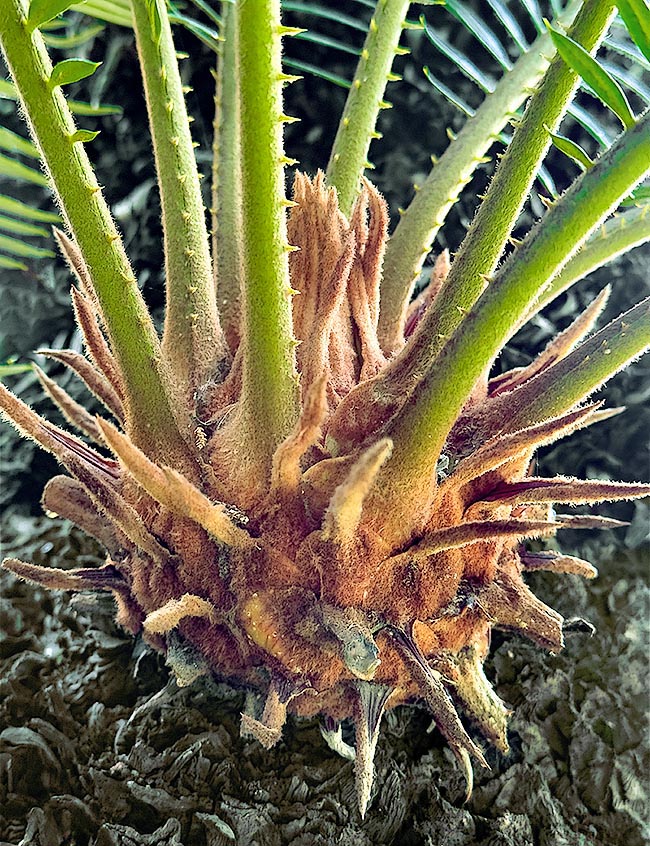
At the base of the leaves stand triangular protective scales with brown tomentum and sharp apex © Giuseppe Mazza
As a matter of fact, some species have survived reaching our days, such as Cycas revoluta, that, rightfully, can be considered as a genuine extant fossil.
Cycas revoluta has an up to 8 m high trunk, columnar, poorly ramified, covered by the old remains of the leaf bases (brown scales), and with numerous basal sprouts (lateral branches).
The roots have secondary rootlets with coralloid enlargements that host colonies of nitrogen-fixing cyanobacteria, like Nostoc and Anabaena that supply the plant mainly with nitrogen, an essential nutrient for its growth.
The young leaves are closed and are covered by a thick down.
The mature leaves, of a bright green colour, are very big (0,7-1,4 m x 20-25 cm), pinnate, coriaceous, arranged in a rosette at the apex of the trunk together with the cataphylls that are triangular (4-5 x 1,5-2,3 cm) with a thick brownish tomentum and sharp apex.
The petiole measures 10-20 cm, with 6-18 spines on each side. The foliar lamina is oblong or elliptic-lanceolate, strongly “V”-shaped in section, curved.
The leaflets, in number of 60-150 pairs, are inserted at about 45° on the central vein (rachis) that is coriaceous, poorly pubescent and with a pungent apex.
Cycas revoluta is a dioecious species like all other Cycadales, which means that male and female individuals do exist.
At the extremity of the stem the males form a pollen cone (strobilus), of pale yellow colour, cylindrical, 30-60 x 8-15 cm with 3,5-6 x 1,7-2,5 cm microsporophylls, spirally arranged on their axis, that have on the lower face the pollen sacs in variable numbers.
The female individuals have megasporophylls of foliar type with 6-8(10) orthotropic ovules, 14-22 cm, densely tomentose. The axis (stem) is 7-12 cm long and the sterile lamina is deeply laciniate, with 1-3 cm 21-35 lobes.
The pollination is done mainly by insects (entomophilic pollination) and occurs from May to July.
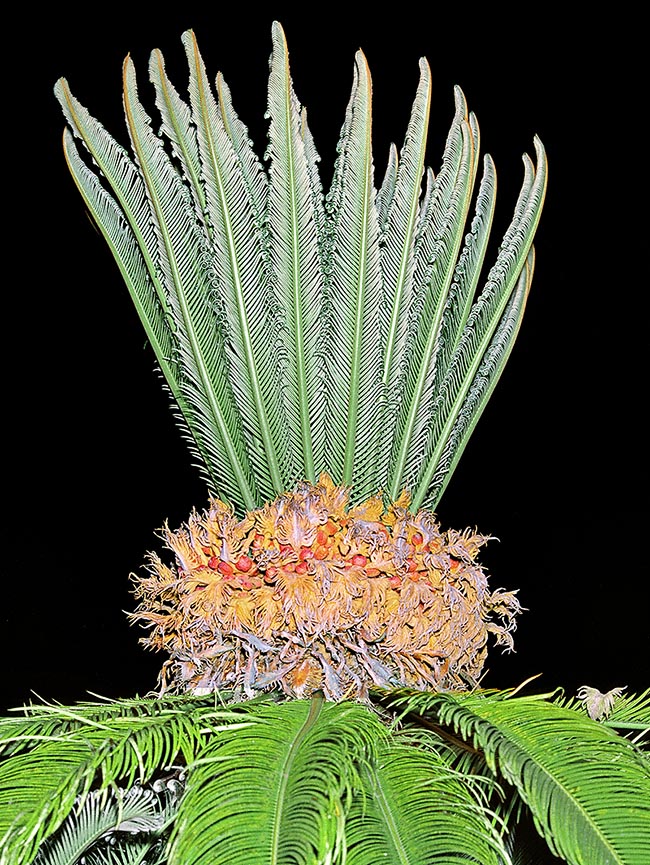
300 million years ago were present male plants and female plants, like this, with its basket of red ovules © G. Mazza
Karyological studies have evidenced that the male individuals as well as the female ones have a chromosomal set of 2n=22 and analyzing the single chromosomes it has been seen that in the chromosomal set of the male plants are present two types of chromosomes (X and Y), whilst in the female ones only one type (XX).
Consequently the phenomenon of the dioecism in Cycas revoluta (present also in all Cycadales) is supported by the presence of the sexual chromosomes (heterosomes) that, during the meiosis, determine the sex of the new individual.
The fecundation takes place on the soil (another character of primitiveness) after pollination. From the pollen grain is emitted a protuberance, the pollen tube, that serves to convey the gametes inside the ovule.
The gametes are ciliate, 180-2210 µm, long, generated by a generative cell and after having been introduced in the ovule by the pollen tube, reach the female reproductive organ (archegonium), swimming in the liquid of the archegonial chamber that allows them to fecundate the oosphere (the female gamete). Only one of them fecundates the oosphere, the other degenerates.
In the absence of an ovary the plant does not form real fruits, but the fecundated ovules transform in fleshy seeds, of red-orange colour, that ripen in the months of September-October. The outer part of the seed is formed by the tegument wrapping the ovule and the seed assumes in this way the look of a drupe. The seeds are ovoid (obovoid), rather compressed, (3)4-5 x 2,5-3,5 cm, slightly pruinose.
The embryo has two cotyledons.
Cycas revoluta is a very ornamental plant and adapts to be cultivated both in the garden, in the more temperate climates, as well as in pot, especially in the sites having a harsher climate. It is a rather rustic plant, resists up to -5(-8) °C, does not like drafts and prefers a high luminosity. Requires water intake, particularly in summer, if cultivated on very loose substrata, otherwise is to be irrigated only when the soil becomes dry to the touch. The excessive irrigation may cause root rot that causes the plant to die.
It propagates in spring by fecundated seeds that are to be buried for about 20 cm but the germination is slow and variable from 50 to 100 days. The reproduction by vegetative means can be done removing the suckers forming at the base of the mother plant and placing them in pots filled up with loose loam, like that for the cultivation of cacti or of palms.
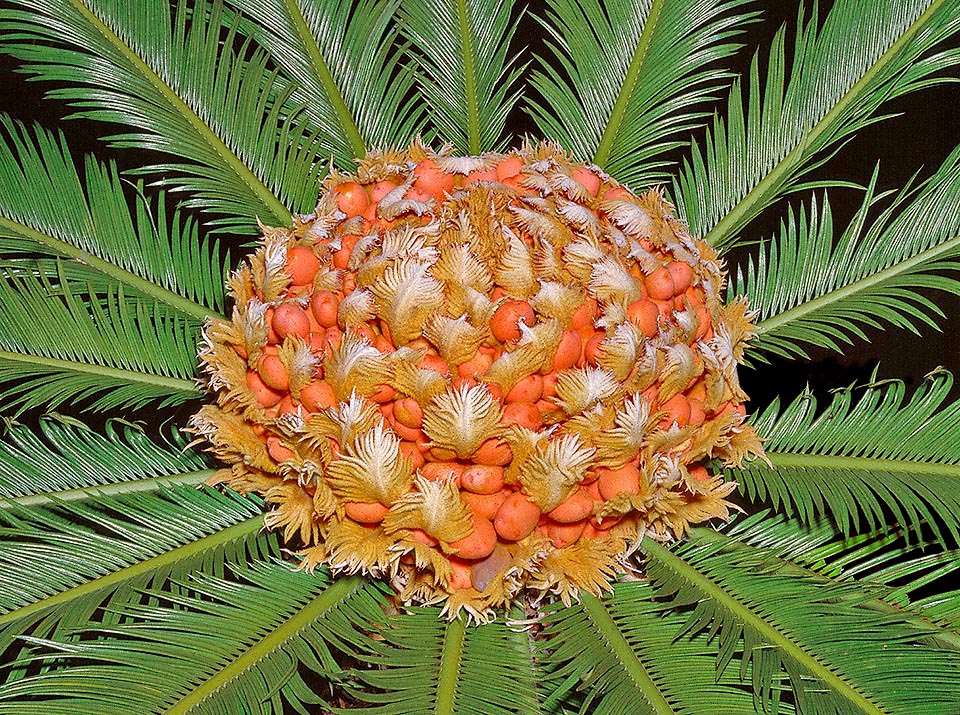
In fact they are not fruits but ovules in the sun waiting for pollination. The fecundation will occur later on the soil when this one has already fallen © Giuseppe Mazza
The fertilization must be done with slow release products, once in spring and one in summer. If nutrient deficiencies are noted, like yellowing of the leaves, the plant can be treated with hydrosoluble fertilizer without exceeding, only once a month. The pruning is to be done only to maintain the plant aesthetically appealing by eliminating the dry leaves. As the leaves are pungent, the use of protective gloves is suggested.
Cycas revoluta has a very slow growth, one round of leaves per year. Therefore, it requires years to reach its maximum size, that usually is 6-7 m of height. In the origin countries are known some live specimens several hundred of years old.
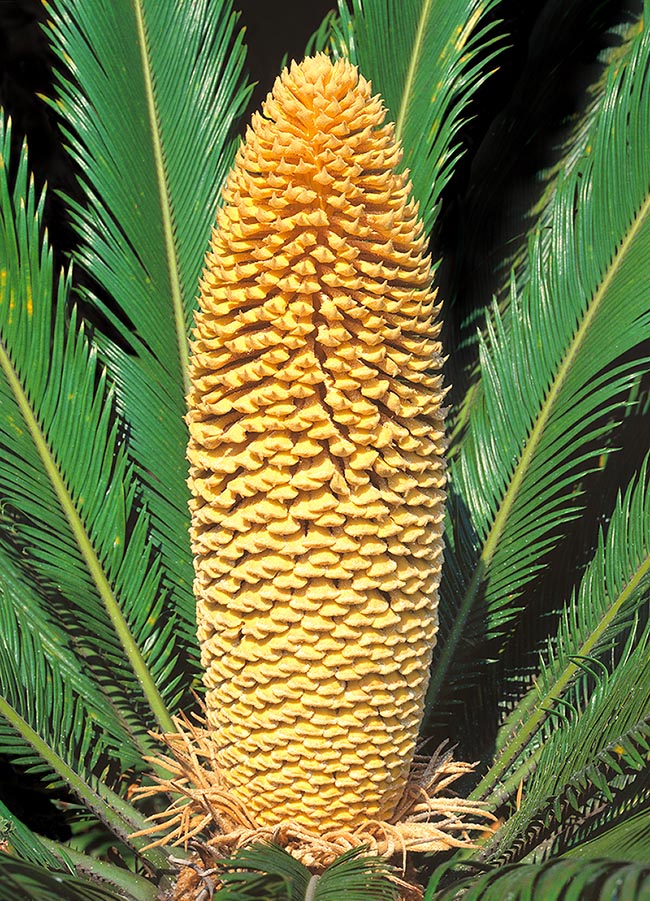
The pollen, produced by cones like this of a male, must in fact send in the ovule through the pollen tube its 2 ciliate gametes that the must reach by swimming the female gamete in the inner archrgonial liquid © Giuseppe Mazza
Cycas revoluta is a very important plant for the local populations as it is utilized for several purposes, also medicinal. As it contains abundant starch, it is used as food, called starch of sago, a starch of wide food use.
For its extraction are utilized plants not yet flowering, by cutting longitudinally the trunks in a way to extract the internal tissue from which the starch is obtained.
Before its use as food the pith extracted from the trunk is ground to obtain a coarse flour and, through a long process, is thoroughly washed for removing the present natural toxins.
Then they proceed to its exsiccation and subsequent cooking in order to obtain a starch for food use, suitable for making bread and various types of sweets.
The sago (or sagù), for the local populations, is a product of remarkable food importance and is even exported.
All parts of the plant are toxic to humans and for domestic animals that appear to find the plant very palatable but the ingestion of leaves or of the seeds causes permanent damages to the inner organs and death.
It is known that the photosynthetic cyanobacteria in the roots of Cycas revoluta produce the neurotoxin called β-N-Methylamino-L-alanine (BMAA) that the plant absorbs and can enter into the human food chain with the seeds that may be eaten directly as source of flour or through wild animals, like the bats, that eat these seeds, and that, in turn, are eaten by the humans. In addition to the Neurotoxin BMAA, present in various species of the genus, Cycas revoluta included, is also found the glycoside cycasin that is present in the seeds in higher concentration.
These toxins if ingested in small doses cause gastrointestinal irritation, vomiting and violent enteritis, if ingested in high doses cause central nervous system depression, convulsion and liver failure. Moreover the compound BMAA has been indicated as a possible agent of Amyotrophic Lateral Sclerosis (ALS). This disease has been found, with incidence rates very high, if compared with the rest of the world, in the Chamorro population of Guam Island (western Pacific Ocean).
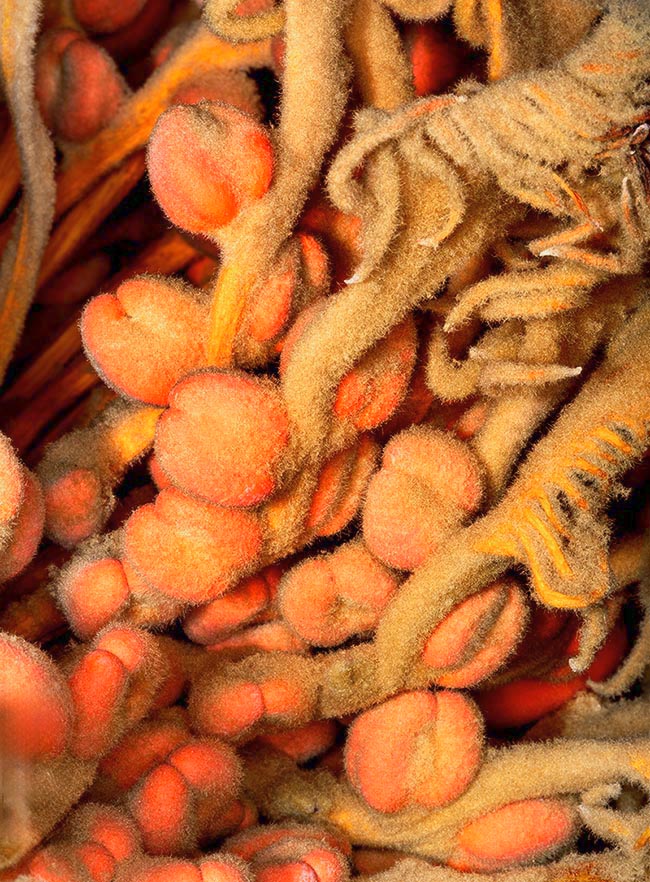
The growing ovules carried by leaf-like structures, are produced in huge quantities © Giuseppe Mazza
After the different assumptions made, it is suspected that the cause may be the utilization, as food, of the seeds of Cycas revoluta (species introduced in the island to improve the landscape) and of Cycas micronesica K.D. Hill (endemic species) and also the flesh of the flying foxes that eat the seeds storing in their fat layers the toxins contained in them. Nowadays the disease has reduced because the eating styles of that population are changing. Mainly, because the megachiropterans are absent. In fact the flying fox endemic to Guam (Pteropus tokudae Tate, 1934) is extinct due to the hunting pressure and the Mariana fruit bat (Pteropus mariannus Desmarest, 1822) is very reduced also due to the accidental introduction on the island of the Brown tree snake [Boiga irregularis (Merrem, 1802)] is drastically reducing the population.
The various parts of Cycas revoluta may be utilized also for flower compositions, funeral wreaths, construction of huts, ropes, brooms, baskets, etc.
In India, in Japan and in Mexico the starch is used for medicinal purposes.
In fact, many local populations use this plant to treat various diseases such as haemorrhoids, painful urination, flatulence and vomiting.
In Cycas revoluta are present many chemical substances like lipids, flavonoids, cycasin, lectin, peptides, biflavonoids, that have antioxidant, antifungal, antitumoral, antileishmanial, antibacterial activities, therefore, once eliminated the toxins, this plant is potentially usable by the pharmaceutical industry.
A recent study has shown that, after the exposition to high doses of ionizing radiation of laboratory animals (rats), injecting extracts of Cycas with an intragastric tuben it has been observed an improvement of the deleterious effect of the radiation with the mitigation of the oxidative stress, the improvement of the haemochrome, the alleviation of the inflammatory mediators in the brain and in the pancreatic tissues. These results, supported also by histopathological observations, have highlighted the potential rôle of the metabolites of Cycas revoluta that can be utilized for therapeutic applications in treating with radiations.
Cycas revoluta is relatively resistant to parasites and diseases. However, occasionally, it may be attacked by mites and mealybugs that cause the yellowing and the wilting of the leaves.
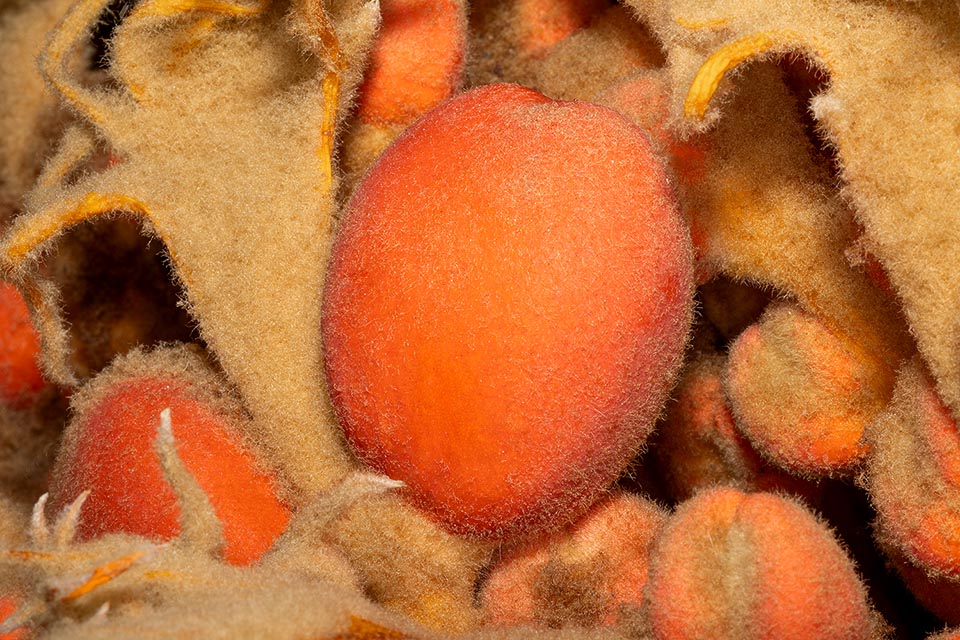
And this is the major difference with the modern flower plants that waste energy for growing them when they are not fecundated © Giuseppe Mazza
These harmful animals can be defeated with mineral oil for horticulture or with insecticidal soap.
If in the soil there is water stagnation, the root rot may occur. In order to avoid this, must be used a well draining loam and avoid the frequent and excessive waterings.
Synonyms: Cycas aurea J.Verschaff.; Cycas inermis Oudem.; Cycas miquelii Warb.; Cycas revoluta subsp. brevifrons Miq.; Cycas revoluta subsp. planifolia Miq.; Cycas revoluta subsp. prolifera Siebold & Zucc.; Cycas revoluta subsp. robusta Messeri; Cycas revoluta var. brevifrons Miq.; Cycas revoluta var. pendula Dallière; Cycas revoluta var. planifolia Miq.; Cycas revoluta var. prolifera Siebold & Zucc.; Cycas revoluta var. robusta Messeri; Epicycas miquelii (Warb.) de Laub.
→ To appreciate the biodiversity within the CYCADACEAE family please click here.
